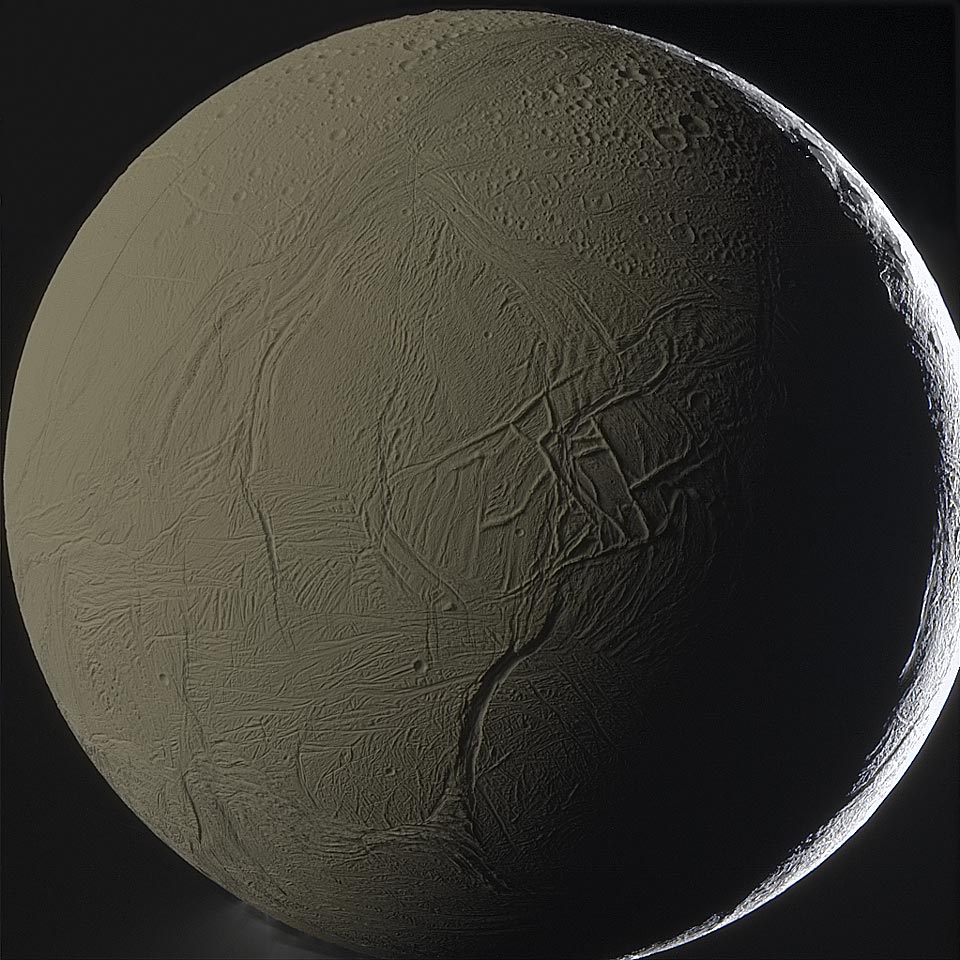Welcome to DU!
The truly grassroots left-of-center political community where regular people, not algorithms, drive the discussions and set the standards.
Join the community:
Create a free account
Support DU (and get rid of ads!):
Become a Star Member
Latest Breaking News
Editorials & Other Articles
General Discussion
The DU Lounge
All Forums
Issue Forums
Culture Forums
Alliance Forums
Region Forums
Support Forums
Help & Search
Science
Related: About this forumAstronomy Picture of the Day - 2023 February 5 - Enceladus by Saturnshine

This moon is shining by the light of its planet.
Specifically, a large portion of Enceladus pictured here is illuminated primarily by sunlight first reflected from the planet Saturn.
The result is that the normally snow-white moon appears in the gold color of Saturn's cloud tops. As most of the illumination comes from the image left, a labyrinth of ridges throws notable shadows just to the right of the image center, while the kilometer-deep canyon Labtayt Sulci is visible just below.
The bright thin crescent on the far right is the only part of Enceladus directly lit by the Sun.
The featured image was taken in 2011 by the robotic Cassini spacecraft during a close pass by by the enigmatic moon.
Inspection of the lower left part of this digitally sharpened image reveals plumes of ice crystals thought to originate in a below-surface sea.
Specifically, a large portion of Enceladus pictured here is illuminated primarily by sunlight first reflected from the planet Saturn.
The result is that the normally snow-white moon appears in the gold color of Saturn's cloud tops. As most of the illumination comes from the image left, a labyrinth of ridges throws notable shadows just to the right of the image center, while the kilometer-deep canyon Labtayt Sulci is visible just below.
The bright thin crescent on the far right is the only part of Enceladus directly lit by the Sun.
The featured image was taken in 2011 by the robotic Cassini spacecraft during a close pass by by the enigmatic moon.
Inspection of the lower left part of this digitally sharpened image reveals plumes of ice crystals thought to originate in a below-surface sea.
https://apod.nasa.gov/apod/ap230205.html
InfoView thread info, including edit history
TrashPut this thread in your Trash Can (My DU » Trash Can)
BookmarkAdd this thread to your Bookmarks (My DU » Bookmarks)
5 replies, 1306 views
ShareGet links to this post and/or share on social media
AlertAlert this post for a rule violation
PowersThere are no powers you can use on this post
EditCannot edit other people's posts
ReplyReply to this post
EditCannot edit other people's posts
Rec (13)
ReplyReply to this post
5 replies
 = new reply since forum marked as read
Highlight:
NoneDon't highlight anything
5 newestHighlight 5 most recent replies
= new reply since forum marked as read
Highlight:
NoneDon't highlight anything
5 newestHighlight 5 most recent replies
Astronomy Picture of the Day - 2023 February 5 - Enceladus by Saturnshine (Original Post)
Ptah
Feb 2023
OP
jpak
(41,780 posts)1. Wow! Holy shite!
What formed that canyon?
Karadeniz
(23,458 posts)2. WOW!!!!
SCantiGOP
(14,296 posts)3. Here is another picture from a great website
Ptah
(33,516 posts)4. Same picture, same website.
SCantiGOP
(14,296 posts)5. Didn't even notice that
That is the first site I look at every morning when I log on. Second is Wordle, and then usually DU.